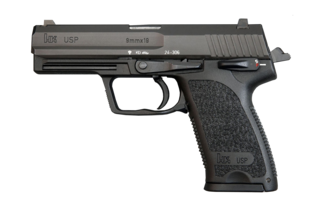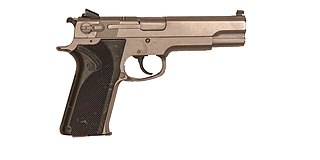
The Browning Hi-Power is a single-action, semi-automatic pistol available in the 9×19mm Parabellum and .40 S&W calibers. It was based on a design by American firearms inventor John Browning, and completed by Dieudonné Saive at FN Herstal. Browning died in 1926, several years before the design was finalized. FN Herstal named it the "High Power" in allusion to the 13-round magazine capacity, almost twice that of other designs at the time, such as the Walther P38 or Colt M1911.

John Moses Browning was an American firearm designer who developed many varieties of military and civilian firearms, cartridges, and gun mechanisms – many of which are still in use around the world. He made his first firearm at age 13 in his father's gun shop and was awarded the first of his 128 firearm patents on October 7, 1879, at the age of 24. He is regarded as one of the most successful firearms designers of the 19th and 20th centuries and a pioneer of modern repeating, semi-automatic, and automatic firearms.
A semi-automatic firearm, also called a self-loading or autoloading firearm, is a repeating firearm whose action mechanism automatically loads a following round of cartridge into the chamber and prepares it for subsequent firing, but requires the shooter to manually actuate the trigger in order to discharge each shot. Typically, this involves the weapon's action utilizing the excess energy released during the preceding shot to unlock and move the bolt, extracting and ejecting the spent cartridge case from the chamber, re-cocking the firing mechanism, and loading a new cartridge into the firing chamber, all without input from the user. To fire again, however, the user must actively release the trigger, allow it to "reset", before pulling the trigger again to fire off the next round. As a result, each trigger pull only discharges a single round from a semi-automatic weapon, as opposed to a fully automatic weapon, which will shoot continuously as long as the ammunition is replete and the trigger is kept depressed.

A semi-automatic pistol is a handgun that automatically ejects and loads cartridges in its chamber after every shot fired. Only one round of ammunition is fired each time the trigger is pulled, as the pistol's fire control group disconnects the trigger mechanism from the firing pin/striker until the trigger has been released and reset.
Double action refers to one of two systems in firearms where the trigger both cocks and releases the hammer.

The USP is a semi-automatic pistol developed in Germany by Heckler & Koch GmbH (H&K) as a replacement for the P7 series of handguns.

The Heckler & Koch P2000 is a German semi-automatic pistol introduced late in 2001 and intended primarily for law enforcement, paramilitary, and commercial markets. It is based on the USP Compact pistol. The P2000 was designed specifically with improved ergonomic characteristics; it has features that reduce handling related stresses, while at the same time increasing user handling and comfort.

The Ruger P series is a line of centerfire semi-automatic pistols made by Sturm, Ruger & Company produced from 1985 to 2013. The P-series pistols were designed for military, police, civilian and recreational use. The designs are largely based on the Browning action found in the M1911 pistol, but with minor variations, generally related to the safety mechanism and the barrel-camblock interface. Reviews have considered them rugged, reliable, and strong, though this strength comes at the price of bulk and a blocky appearance.
The FN 140DA was a semi-automatic weapon manufactured by Beretta of Italy on behalf of FN Herstal of Belgium. The pistol was sold as the Browning BDA 380 in the United States and Canada.
Dieudonné Joseph Saive was a Belgian small arms designer who designed several well-known firearms for Belgian armsmaker Fabrique Nationale, including the Model 1949 and the FAL rifles. He is also known for modifying several of John Browning's firearms designs, including the 1931 Baby Browning and Browning Hi-Power pistols.

In American English, a pocket pistol is any small, pocket-sized semi-automatic pistol, and is suitable for concealed carry in a pocket or a similar small space.
The FN Forty-Nine is a recoil operated, locked breech semi-automatic pistol developed by the Belgian company FN Herstal, and manufactured in the United States. The name of the pistol reflects its two chamberings, .40 S&W and 9×19mm Parabellum, while also matching the manufacturer's initials (FN).

The Beretta 8000 (Cougar) is a family of rotating barrel semi-automatic pistols that were designed and manufactured by Beretta of Italy.

A trigger is a mechanism that actuates the function of a ranged weapon such as a firearm, airgun, crossbow, or speargun. The word may also be used to describe a switch that initiates the operation of other non-shooting devices such as a trap, a power tool, or a quick release. A small amount of energy applied to the trigger leads to the release of much more energy.

The S&W Model 4006 is a semi-automatic handgun introduced by Smith & Wesson on January 17, 1990 along with the new .40 S&W cartridge. It is a 3rd-generation S&W pistol.

The Smith & Wesson Model 4506 is a third-generation semi-automatic pistol from Smith & Wesson's 4500 series of handguns. The 4506 is chambered for the .45 ACP cartridge and, with the purchase of special springs, the stronger .45 Super. It is constructed almost entirely from stainless steel and is thus extremely resistant to harsh weather conditions. The 4506 is a traditional double-action/single-action pistol. The first shot is fired in double-action mode. Each subsequent shot is fired in single-action mode. It features one-piece Xenoy wrap-around grips with either a curved or straight back strap. The 4506 was produced from 1988 to 1999.

A handgun is a firearm designed to be usable with only one hand. It is distinguished from a long gun which needs to be held by both hands and braced against the shoulder. Handguns have shorter effective ranges compared to long guns, and are much harder to shoot accurately. While most early handguns are single-shot pistols, the two most common types of handguns used in modern times are revolvers and semi-automatic pistols, although other handguns such as derringers and machine pistols also see infrequent usage.

FN HP-DA is a 9mm semi-automatic pistol developed by Belgian Fabrique Nationale arms factory in Herstal. In North American markets, it was marketed as the Browning BDA and is also referred to as Browning DA and Browning Hi-Power BDA.

In firearms, a safety or safety catch is a mechanism used to help prevent the accidental discharge of a firearm, helping to ensure safer handling.














